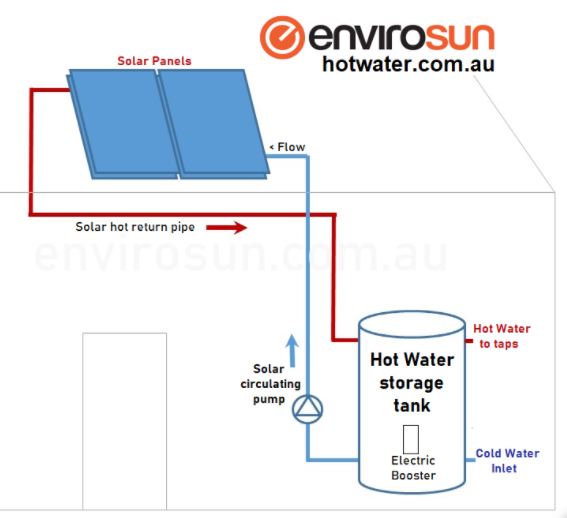
Solar Hot Water Systems Explained
Lots of homeowners know the benefits of solar hot water systems, but most people have no understanding of the ins and outs. For those who want to become environmentally-friendly and protect the planet, these systems could assist in helping you to achieve that goal. Just take a moment to read through the information below to ensure you grasp the concept and all the benefits.
You can then make an informed decision on whether or not a solar hot water system is suitable for your property. Don’t panic if you decide these devices aren’t for you as there are plenty of other options that we can also help with such as Gas or Electric. However, for most homeowners, going green with solar solutions is a fantastic move.
So, how does solar hot water work?
Solar hot water systems will help your family to reduce their greenhouse gas emissions, and they should also help you to save a lot of energy in the home. Most solutions use two different types of collectors for solar hot water. They are called flat plate collectors, and evacuated tubes. Both collectors are suitable for either roof mounted or split system installations. If you are a frost prone area, a frost valve will need to be installed on your flat plate collector, this prevents the copper tubing inside the collector splitting and eventually leaking. Evacuated tubes are an excellent choice for frost prone locations and do not require a frost valve. Which panel is more efficient? This depends on the size of the flat plate panels and the number of evacuated tubes. The bigger the flat plate collector and the bigger the number of evacuated tubes, the bigger and better the efficiency.
How do flat plate collectors work?
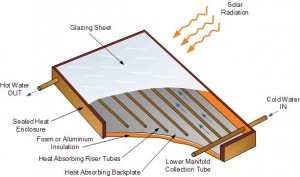 A flat plate collector is a rectangular metal framed collector, typically with a 4mm thick glass cover on top and an absorber plate on the bottom. The absorber plate is usually coated in a black surface which is used for absorbing radiation energy. The sides and bottom of the collectors are usually insulated to minimise heat loss. Inside the collector are copper pipes which connect to the storage tank either on the roof or on the ground. As the sun starts beating down, the rays heat the copper pipes and warm the water inside the storage tank.
A flat plate collector is a rectangular metal framed collector, typically with a 4mm thick glass cover on top and an absorber plate on the bottom. The absorber plate is usually coated in a black surface which is used for absorbing radiation energy. The sides and bottom of the collectors are usually insulated to minimise heat loss. Inside the collector are copper pipes which connect to the storage tank either on the roof or on the ground. As the sun starts beating down, the rays heat the copper pipes and warm the water inside the storage tank.
If the tank is on the ground (known as a split system installation), the hot water is transferred to the storage tank via a circulation pump. You can then access the water from your taps and benefit from the heat without having to use vast quantities of electricity and gas like you would with traditional solutions.
Pros
More affordable than evacuated tubes
Flat plate collectors are less expensive to purchase compared to the alternative because they are cheaper to manufacture. That said, the price difference between the two options decreases every single year, and so it’s always sensible to consider both solutions before making your decision.
Simple to install and use
Flat plate collectors use an absorber sheet placed between glass and a layer of insulation. The design is about as simple as it can be, and installing the device shouldn’t take more than a couple of hours for most professionals.
Low profile
It doesn’t take a rocket scientist to work out where these devices get their name. Flat plate collectors have a shallow profile, and that means they’re often unnoticeable from the street.
Easy to maintain
When it comes to maintaining flat plate collectors, the task is straightforward and there are no parts to be replaced inside a collector. Cleaning them annually will help to improve solar efficiency.
Cons
Frost valve required for freezing temperatures
In frost prone areas, a frost valve is required to be fitted to prevent the copper tubes inside the collector splitting then leaking. We wouldn’t really refer this as a Con, just a standard requirement but something to note)
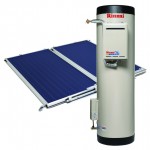
Requires more roof space
The bigger the flat plate collector, the greater the solar efficiency. The standard collector size is 2m x 1m and a typical solar hot water installation would have 2 of these collectors installed, so 4m x 2m overall. However, for greater efficiency, some manufacturers produce panels which are 2.5m x 1m wide, so 5m x 2m wide per installation. Naturally, this takes up more roof space, but this isn’t an issue if you have ample roof space, or don’t have any PV solar panels installed.
How do evacuated tubes work?
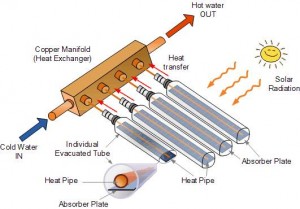 The system uses two fused glass tubes to form a vacuum, and then a copper pipe running through the centre gets connected to a slow flow circulation pump. That pump then pushes water to a storage tank located below.
The system uses two fused glass tubes to form a vacuum, and then a copper pipe running through the centre gets connected to a slow flow circulation pump. That pump then pushes water to a storage tank located below.
Due to the insulation of the tank, evacuated tubes will provide hot water during both the daytime and the nighttime. Unlike flat plate collectors, evacuated tubes do not require sunlight to function correctly. That means they are often the solution of choice for many homeowners in Australia and beyond. The tubes can extract heat from humid air, and that increases their performance when the sun is not in the best position.
Pros
Handles wind better than the alternative
Evacuated tube collectors outperform flat plate collectors in windy conditions. While the flat solution will lose heat, evacuated tube solutions provide better insulation, and so that should never happen.
More compact
Lots of people want to save space on their roof for other solar devices that power their homes. Evacuated tube collectors have a smaller footprint when compared to the alternative, and so they’re the best option for those who worry about the amount of weight on their roofs at the moment.
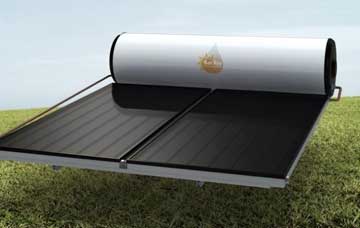
Cons
More expensive than flat plate collectors
As discussed a moment ago, the price difference between flat plate collectors and evacuated tube collectors decreases all the time. However, you can’t ignore the fact that the latter solution is still more expensive.
Heavier than the former option
Most homeowners shouldn’t have to worry too much about the weight of the items they place on their roofs. Still, that can become a concern for some people with old houses or lots of other devices up there.
More breakable and fragile
If you’re looking for something that is going to stand the test of time; you might want to think twice about evacuated tube collectors. Compared to the alternative, they are more fragile and tend to require more frequent repairs.
Longer installation period
While it’s easy to lift an evacuated tube collector onto your roof, it also takes a long time to install due to the many different parts. Every vacuum tube has to go into place separately, and that means someone is going to spend quite a few hours on the roof.
So, which solution is the most efficient?
It’s a common myth that evacuated tubes are more efficient than flat plate collectors. Beware of these efficiency claims, the are usually wrong! The STC (small-scale technology certificates) are an independent indicator of a systems efficiency. The higher the value, the higher the efficiency of the system. The size of the tank has no impact efficiency, it’s the collectors/tubes that determine the efficiency. When comparing systems, we need to compare apples with apples and not apples with oranges. So lets’s look at some examples:
Flate Plate Collector vs Evacuated Tube Collector – Same Manufacturer (based on Zone 3, Queensland)
- Flate Plate Collector System – Phoenix 340 ltr solar hot water split system with 2 x 2m2 collectors – STC Value = 38
- Evacuated Tube System – Pheonix 340 ltr solar evacuated tube split system with 30 tubes – STC Value = 36
- Thus, using the same manufacturers system, the more efficient collector is the Flat Plate Collector.
If we compare the largest system of the same manufacturer with larger flat plate collectors vs larger number of tubes (based on Zone 3, Queensland)
- Flat Plate Collector System – Phoenix 340 ltr solar hot water split system with 2 x 2.5m2 collectors – STC Value = 43
- Evacuated Tube System – Phoenix 340 ltr solar evacuated tube split system with 40 tubes – STC Value = 43
- Thus, using the same manufacturers larger system, the flat plate collector and the evacuated tube collector are equally efficient.
If we compare different manufacturers systems of large flat plate collectors vs larger number of tubes (based on Zone 3, Queensland)
- Flate Plate Collector System – Pheonix 340 ltr solar hot water split system with 2 x 2m2 – STC Value = 38
- Evacuated Tube System – Apricus 315 ltr solar hot water split system with 30 tubes – STC Value = 37
- Thus, using different manufacturers smaller systems, the more efficient collector is the Flat Plate Collector.
If we compare different manufacturers systems of large flat plate collectors vs larger number of tubes (based on Zone 3, Queensland)
- Flate Plate Collector System – Phoenix 340 ltr solar hot water split system with 2 x 2.5m2 – STC Value = 43
- Evacuated Tube System – Apricus 315 ltr solar hot water split system with 44 tubes – STC Value = 37
- Thus, using different manufacturers larger systems, the more efficient collector is the Flat Plate Collector.
It is important when asking the question, which is more efficient, that we compare collectors and tubes equally. The answer can be very different depending on manufacturer, size of panels and number of tubes. However, most importantly the efficiency will vary greatly depending on installed location. The efficiency calculated in Melbourne on the system systems, for example would differ greatly to the efficiency calculated in hotter Queensland weather.
What about electric and gas boosters?
Solar hot water systems are excellent tools for reducing your energy consumption and providing your home with warm water all year round. However, sometimes when the sun is not out and we experience cloudy or rainy days and through extended periods of adverse weather conditions we want to give the system a helping hand with electric and gas boosters. It’s vital that you have a backup in place if you don’t want to encounter issues.
The most efficient method of boosting your hot water is to install via electric booster. Typically, roof mounted systems will have an internal booster switch which you can control as required. A typical split system installation, will not require a booster switch as the boosting is automatically performed as detected by the roof and tank sensor probes installed on the system. The booster will kick-in whenever the temperature inside your tank drops below a certain level. Typically most solar hot water tanks are a mid element tank meaning that they boost from the middle of the tank. So for example, if you have a 300 ltr tank, the boost function would typically “boost” or heat the top 150 ltrs of your tank. 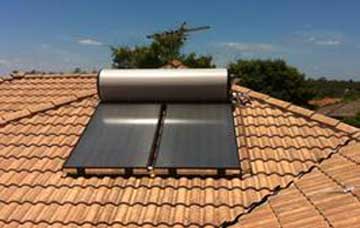
Running your booster via Natural or LPG gas is an option. If you already have Natural Gas installed in your house for cooking, then running Natural Gas for hot water might be a suitable option. However, if you are considering installing Natural Gas just for the purposes only of boosting your solar hot water system, you might want to consider the ongoing costs of having Natural Gas connected to your property. The quarterly costs charged by the gas provider usually outweigh the costs of boosting and therefore you would most likely find it cheaper to run as an electric backup. Similar situation is with LPG Gas. Usually with the costs of LPG gas coupled with the amount of gas required to produce decent pressure of hot water, means ongoing running costs are fairly high and it would be more viable to have an electric backup in place.
What Electricity Tariff should my solar hot water system be on?
It is recommended that all solar hot water systems run on Tariff 33.. This is an off peak tariff and will not heat during peak times of 7am and 9am and 4pm and 8pm. This is controlled by Energex and the times may vary at their control. The system will heat, or boost from its element positioning (most commonly mid element, but some systems have a top element).
- If you had a 300 ltr mid element tank, then boosting of the tank would boost the top 150 ltrs.
- If you had a 400 ltr mid element tank, then boosting of the tank would boost the top 200 ltrs.
- If you had a 300 ltr top element tank, then boosting of the tank would boost the top 60 ltrs.
- If you had a 400 ltr top element tank, then boosting of the tank would boost the top 80 ltrs.
The system would reheat during the off peak times as required.
It’s not incorrect to run on Tariff 31 but you risk the chance of running out of hot water. Here’s how it works.
Tariff 31 typically kicks in around 10-11 pm at night and kicks out around 7 am. The first person to have a shower usually has lovely hot water, but gradually as the day continues the water runs cold. Then the following morning, again, lovely hot water in the morning and then graudally runs cold. Why? It’s because the system is boosting from the element positioning up. So if you’ve got a 300 ltr tank, then it’s only boosting 60 ltrs. What happens when the 60 ltrs runs out? Well you get no more hot water until Tariff 31 kicks back in at 10-11 at night. It might be okay if you’re a one person family and thus if you can manage with that small amount of hot water then you’re set. But if there’s a few of you in the family, then I doubt 60 ltrs will get you very far! Hence, why we always recommend Tariff 33.
Well, how much energy can I save?
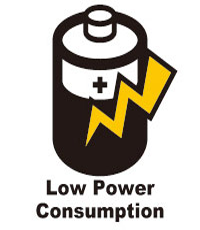 Research shows that traditional hot water systems account for around 20% of all greenhouse gas emissions in the average home today. By selecting a solar alternative, you can reduce those emissions and also save approximately 80 – 90% of your monthly water heating expenses
Research shows that traditional hot water systems account for around 20% of all greenhouse gas emissions in the average home today. By selecting a solar alternative, you can reduce those emissions and also save approximately 80 – 90% of your monthly water heating expenses
Now you know more about solar hot water systems; you should manage to make the right decisions when improving your home this year. Regardless of which option you select; you will reduce your household’s energy consumption and greenhouse gas emissions.
Contact us TODAY to get started (or just give us a call if you have further questions).






